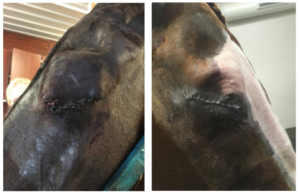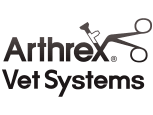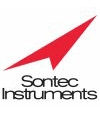Enucleation is the surgical procedure used for the removal of one or both of a horse’s eyes. In horses, this procedure is most commonly used in cases of severe trauma to the globe or chronic painful ocular disease to improve the patient’s comfort. The procedure is typically well tolerated by horses, and many animals with a unilateral enucleation can return to their previous discipline.
Indications for enucleation include:
- Severe Ocular Trauma: This may include penetrating wounds or rupture of the globe, where restoration of a non-painful, functional eyeball is highly unlikely.
- Chronic Ocular Disease: This may include chronic uveitis (equine recurrent uveitis or moon blindness), severe corneal ulceration, or glaucoma. Clinical signs can include squinting, tearing, increased discharge, cloudiness or change of color of the eye, or blindness.
- Ocular neoplasia/tumors are uncommon but may also be an indication for enucleation.
These disorders may become refractory to medical management, or the horse may continue to have pain despite conservative therapy. Intractable eye pain and unresponsiveness to medical management are often indications for enucleation.
Before selecting enucleation as a treatment for your horse, your veterinarian will first perform a complete ophthalmic/eye exam. This will typically include the use of a darkened space, sedation, and periocular nerve blocks. Typically, a fluorescein stain test is performed to assess corneal ulcers. Additional diagnostics which may be implemented include tonometry (measuring intraocular pressure), ultrasound of the globe, or advanced imaging such as CT or MRI. In cases of ocular tumors, a biopsy may be taken to identify the type of neoplasia.
Commonly, medical treatment will be attempted prior to electing enucleation surgery as a last resort; however, in severe cases of trauma or disease, enucleation may be the best option for the horse.
Enucleation may be performed under general anesthesia or with standing sedation and local anesthesia (nerve blocks), depending on the temperament of the horse, exact characteristics of the disease, and surgeon preference. Straightforward enucleation involves the removal of the globe, supporting soft tissues (third eyelid, conjunctiva, and the eyelid margins), and can be performed using several possible techniques depending on the surgeon’s preference and the pathology necessitating enucleation. At the end of this surgery, the globe will be removed and the eyelids closed, resulting in skin fully covering the empty socket (Figure 1). Occasionally, intraorbital prostheses will be placed prior to skin closure, which may reduce the sunken appearance at the site, which commonly occurs after healing. Prostheses can increase the postoperative infection risk and should not be used in cases of infection or neoplasia.
More rarely, alternative techniques may be used, which may remove more or less tissue than enucleation.
- Evisceration involves removing the contents of the globe while preserving the scleral shell, which is then filled with an implant or prosthesis to maintain orbital volume and cosmetic appearance. This will make it appear that a globe is still present; however, the inner contents were removed, and no vision is present. This procedure is rarely performed and can only be used with a small number of disease processes; however, this provides a more cosmetic outcome than enucleation.
- Exenteration involves removing the entire contents of the orbit, including the eyeball, associated muscles, and surrounding tissues. This procedure is more extensive than enucleation and is used to address extensive disease or neoplastic involvement within the orbit.
While rare, potential surgical complications may include post-operative infection, hemorrhage, damage to surrounding structures (such as the optic nerve or orbital vessels), inadequate closure of the eyelids, or post-operative swelling and discomfort.

Pain management, antibiotics, and incision care are routine following surgery. Feeding horses off the ground for several days following surgery may help reduce swelling of the surgery site. Often, horses were blind in the affected eye prior to removal, and adjustment to having an eye removed is uneventful, but horses who sustained an acute injury necessitating enucleation may have more of an adjustment period. It is important to keep these horses in a safe, familiar area while they adjust to their new world. Most horses adapt to enucleation very well, and horses with unilateral enucleation often can return to their previous profession. For horses suffering from chronic ocular pain, enucleation can significantly improve their quality of life, and many owners describe their older horses showing an energy they hadn’t seen in months to years.













